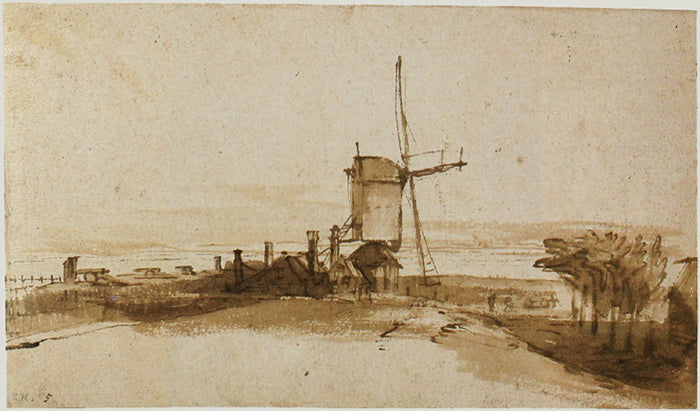説明
Rembrandt's The Mill at Het Blauwhoofd, painted in 1650, falls within a period938 of the Dutch master's production that masterfully explores landscape and the interplay of light and shadow with architecture and nature. Capturing a distinctive Dutch rural landscape, this oil on canvas reflects both Rembrandt's aesthetic vision and his deep understanding of the environment that surrounded him, an environment that was in constant connection with the daily life of his time.
Visually, the painting is characterised by an energetic and balanced composition. The windmill, which occupies a central and dominant position, stands majestically against a sky that varies in shades of grey, blue and white, suggesting the imminent arrival of a storm. The structure of the windmill, although of a simple architectural style, is carefully detailed, displaying Rembrandt's ability to capture the essence of forms and textures. The blades of the windmill, extending towards the sky, add a sense of movement and dynamism to the scene, which contrasts with the earthly stability of the windmill itself.
Rembrandt's palette is subtle and nuanced. Earthy tones predominate, interspersed with hints of green and blue, which serve to evoke the richness of the Dutch agricultural landscape. Light, an essential element in the artist's work, is introduced dramatically, illuminating the windmill and its immediate surroundings, while the background recedes into deeper shadows. This chiaroscuro technique is a signature of Rembrandt, who uses light not only as an aesthetic element, but as an emotional vehicle that guides the viewer's gaze through the painting.
While The Mill at Het Blauwhoofd does not feature explicit human figures, the choice of landscape and the structure of the mill speak to the presence of rural daily life in 17th-century Holland. The mill, a symbol of progress and agricultural labour, reflects the centrality of field work in the cultural narrative of the time. Through this choice, Rembrandt not only portrays a physical setting, but also evokes the history of the community that depends on the mill for its livelihood.
In addition to its visual content, the work has a significant historical background. During the 17th century, the Netherlands experienced a boom in landscape painting, and Rembrandt excelled in this movement, often infusing his landscapes with a deeper emotional charge. Although the painting is primarily identified with the classical landscape tradition, influences from naturalistic art are also evident, showcasing Rembrandt's meticulous attention to detail and his ability to transform the mundane into something sublime.
In conclusion, "The Mill at Het Blauwhoofd" is a work that not only depicts an iconic landscape, but also acts as a testament to Rembrandt's mastery in the use of light and color, as well as his ability to transcend the apparent and connect with the essence of human life. Through this painting, we witness the intersection between nature, culture and the future of the society in which the artist lived, allowing each viewer to experience the history and emotion that unfolds in this masterful representation.
KUADROS ©, a famous painting on your wall.
Hand-made oil painting reproductions, with the quality of professional artists and the distinctive seal of KUADROS ©.
Painting reproduction service with satisfaction guarantee. If you are not completely satisfied with the replica of your painting, we will refund 100% of your money.

